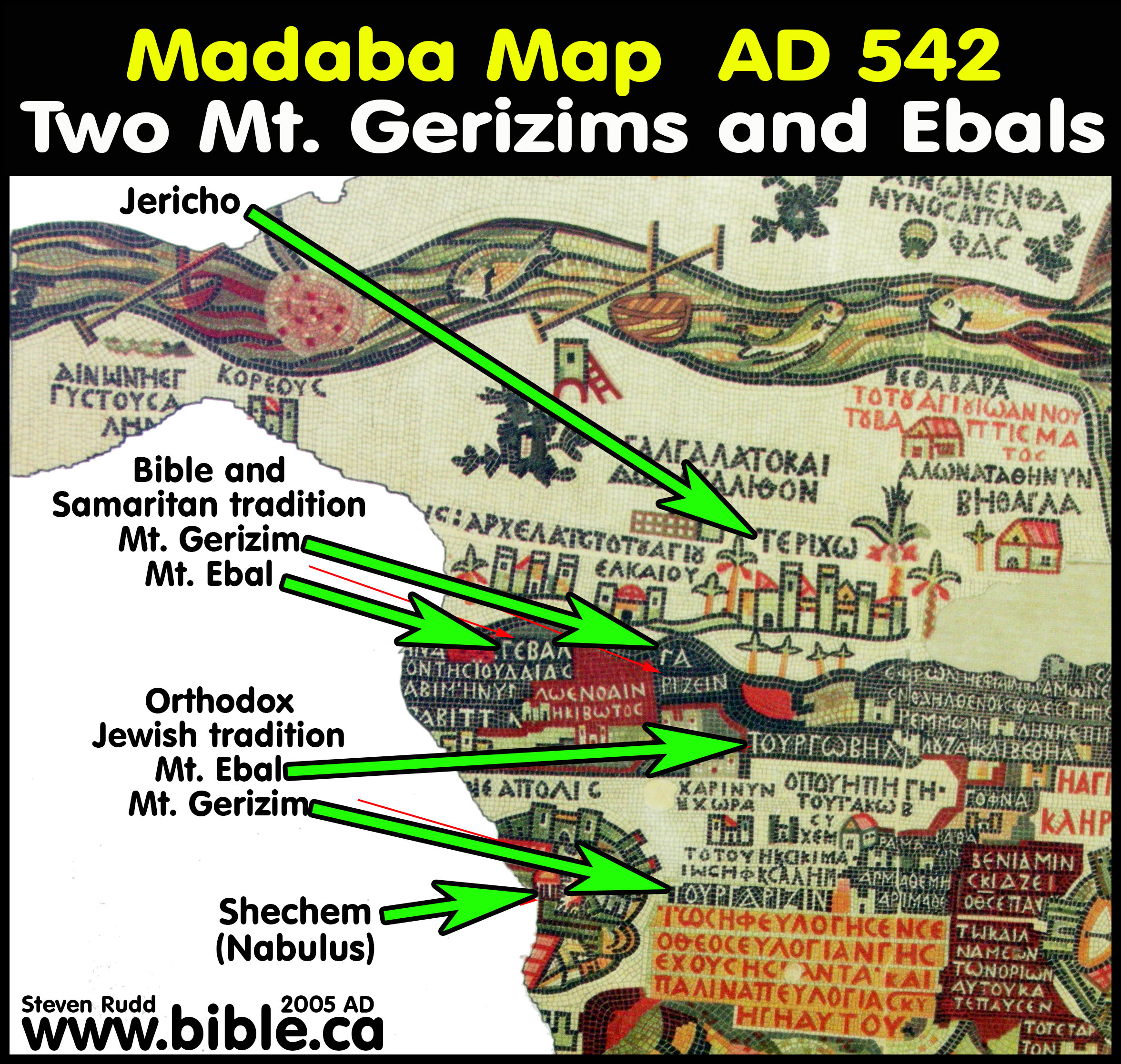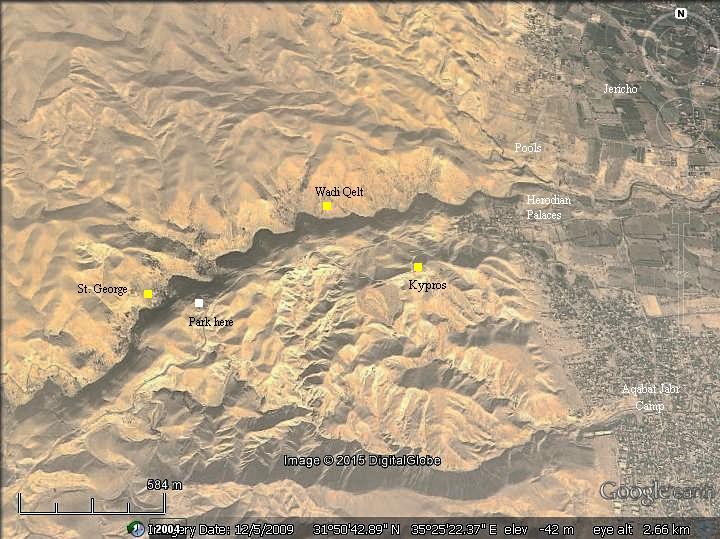1. the Samaritans thought that Gerizim had a peak that went all the way up to Paradise/heaven.
2. the Marcionite gospel has Jesus descend on to the place that Adam was created on the road between Jericho and Jerusalem
There doesn't seem to be any connection between these two facts but Jerome provides some more curious information to tie everything together:
For some unknown reason Jerome seems to think that mount Gerizim and Ebal were located here:Even in this order the account is extremely short and general as compared with the detailed history of the campaigns which follow; the first in the south, including the siege and taking of seven cities, and the next in the north, recording the invasion of Galilee and the defeat of the league of six kings of Northern Palestine.
The Book of Joshua itself contains no indication that Mount Ebal was near Shechem, but in Deut. xi. 30 we find the two mountains defined as being "in the champaign (Arabah, generally rendered "desert") over against Gilgal, beside the plains of Moreh." The plain or oak of Moreh, famous in the history of Abraham, is connected with Shechem in the expression, "Unto the place of Shechem, unto the plains of Moreh" (Gen. xi. 6). Josephus, in a more definite manner, places the two mountains at Shechem (Ant. iv. 8. 44), defining the situation of the altar as "not far from the city of Shechem, which is between the two mountains, that of Gerizim, situate on the right hand, and that of Ebal on the left."
Thus there is no reasonable doubt as to the position of these mountains ; yet in the fourth century we find Jerome writing (Ono m. s. V. Gebal) :-
"A mountain in the promised land where, by order of Moses, an altar was built. There are near (juxta) Jericho two mountains close together looking towards one another, one of which is called Gerizim, the other Ebal. Nevertheless, the Samaritans say that these two mountains were near Neapolis (Shechem}, but they err enormously (sed vehementllr errant), for they are some distance apart, nor could· the voices of those blessing and cursing be heard, which is said to have been the case in Scripture."
And again, under the· head Golgol, Jerome makes a note : " Near which the mountains Garizin and Gebal are recorded to have been situate. But Galgal is a place near Jericho. Therefore the Samaritans err who desire to point out the mountains of Garizin and Gebal near Neapolis, when Scripture bears witness that they were near Galgal." It is probable that the two points referred to by Jerome are the prominent peaks now called Tuweil el 'Akabeh and Nuseib 'Aweishtrehc (i.e., "the monument of the tribes"), either side of the road from Jericho to Jerusalem along Wady Kelt. It appears, however, that this was merely a hearsay report, probably obtained by Jerome from Jews who had not forgotten their old animosity to their Samaritan rivals. https://biblicalstudies.org.uk/pdf/pefq ... 04_182.pdf

Gerizim was a heavenly ladder. Curiously this is also the place that the Marcionites said Jesus descended. Another entry:
The idea of a "Christian Gerizim" would help explain the Marcionite hostility to the covenant of Israel too. More:No better modern locality for this :has yet been found than Wady Kelt, a ravine which empties-into the Jordan plain opposite Jericho. It is thus described by Lieutenant Conder (Tent-Work, ii, 21)
"Wady Kelt has been thought to be the Brook Cherith, and -the scene seems well fitted for the retreat of the prophet who was fed by the Oreb, whom some suppose To have been Arabs. The whole gorge is wonderfully wild and romantic; it is a deep fissure rent in the mountains, scarcely twenty yards across at the bottom, and full of canes and rank rushes between vertical walls of rock. In its cliffs the caves of early anchorites are hollowed, and the little monastery of St. John of Choseboth is perched above the north bank, under a high, brown precipice. A fine aqueduct from the great spring divides at this latter place into three channels, crossing a magnificent bridge seventy feet high, and. running as total distance of three miles and three quarters, to the place where the gorge debouches into the Jericho plain. On each side the white chalk mountains tower up in fantastic peaks, with long, knife-edged ridges, and hundreds of little conical points, with deep torrent- seams between. All is bare and treeless, as at Mar Saba. The wild pigeon makes its nest in the secret places of the stairs of rock the black grackle suns its golden wings above them; the eagle soars higher still, and over the caves by the deep-pools the African kingfisher flutters; the ibex also still haunts the rocks. Even in autumn the murmuring of water is heard beneath, and the stream was one day swelled by a thunderstorm, in a quarter of an hour, until it became a raging torrent, in some places eight or ten feet deep.
⇒See also the International Standard Bible Encyclopedia.
"The, mouth of the pass is. also remarkable for on either, side is a conical peak of white chalk-one on the south, called the peak of the ascent (Tuweil el 'Akabeh), while that to the north is named Bint Jebeil, daughter of the little mountain, or Nusb 'Aweishireh, monument of the tribes.
"These peaks are again, to all appearance, connected with a Christian tradition. Jerome speaks of Gebal and. Gerizim. as two mountains close together, shown in his day just west of Jericho. In the name Jebeille may perhaps recognise the Gebal of this tradition and in that case the monument of the tribes would be the tradition an altar of Joshua in Eball. If this be so, the southern peak must be the early Christian Gerizim; but the name is apparently lost." (See engraving on opposite page.)https://www.biblicalcyclopedia.com/C/ch ... ok-of.html
3. The Early Christian Ebal and Gerizim were situate, as I have pointed out in the paper on Samaritan topography, near Jericho. I have proposed the two conical summits north and south of the gorge of Wady Kelt. The northern has traces of ruins upon it, and is called by the curious title Nusb 'Aweishireh, of the meaning of which there is no doubt. Nusb means anything standing erect, a cairn, a column, a mileston"l, or a crag; the other word is the plural of '.Ll.shireh, "a tribe," and the whole may consequently be translated " the monument of the tribes." A tradition on the subject may very easily be collected, as the Abu Nuseir Arabs who inhabit this district are remarkably intelligent; but at first sight one naturally connects the title with the early Christian tradition as to Ebal and Gerizim, which are described as two peaks close together. (See Q. S. April, 1874, p. 74 ) https://biblicalstudies.org.uk/pdf/pefq ... 04_167.pdf



